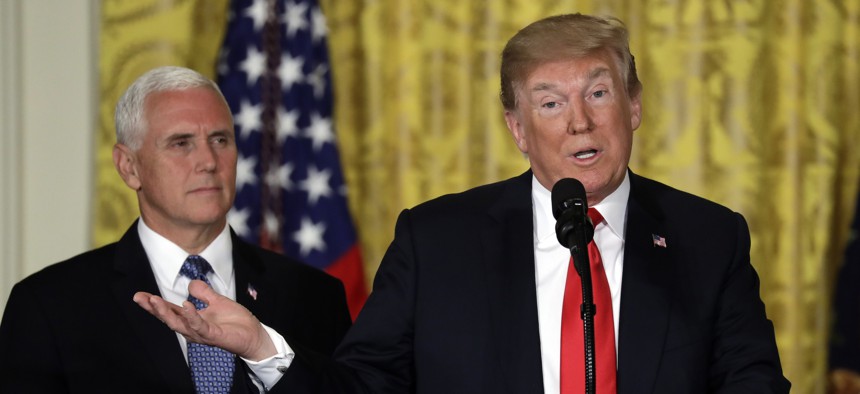
President Donald Trump speaks at a June 2018 meeting of the National Space Council, which is led by Vice President Mike Pence, left. AP Photo/Evan Vucci
White House Seeks Alternatives to Independent Space Force
Pentagon leaders were dutifully double-timing toward a new military branch. Then they got new marching orders.
For months, Pentagon officials have been rushing to prepare plans for an independent Space Force, a sixth branch of the military ordered up by President Trump. But since Oct. 26, they have been marching to new White House orders: go back and look at different ways to reorganize the military’s space operations.
One of the four new options is an old one, defense officials said: a space corps that would be part of the Air Force, the way the Marine Corps is part of the Department of the Navy. The proposed structure is similar to a bipartisan proposal that passed in the House but failed in the Senate last year.
Why the second thoughts? The officials, who spoke on the condition of anonymity, suggested that some in the Trump administration fear that the proposed independent Space Force might not make it through Congress.
A former senior defense official said Pentagon officials would be more comfortable with a space corps within the Air Force, but feel Trump’s comments that he wants a “separate but equal” space force have given them little wiggle room.
The four options, according to one of the officials, include: 1) an Air Force-owned space corps that includes only Air Force assets, 2) an Air Force-owned space corps that also takes space-related troops and assets from the Army and Navy, 3) an independent service that takes from the Air Force, Army, and Navy, and 4) an independent service that takes from the three services plus parts of the intelligence community.
Related: Here’s The Pentagon’s Initial Plan For Creating a Space Force
Related: Trump’s Space Force Faces an Uncertain Fate
Related: Senior Defense Officials Offer Dueling Pricetags for Space Force
Vice President Mike Pence and Deputy Defense Secretary Patrick Shanahan — who are leading the reorganization of the military’s space operations — are scheduled to meet Thursday. The two are to discuss the options.
“As part of an ongoing review, the Department is developing options for a Space Force as a sixth military service branch to implement the President’s vision and guidance,” Lt. Col. Joseph Buccino, a Defense Department spokesman, said in an email.
A White House spokeswoman declined to comment.
No matter which option is chosen, the new organization is likely to be called “Space Force”, according to an Oct. 26 White House memo to the Pentagon. The memo is from Scott Pace, who is the National Space Council’s executive secretary, and Earl Matthews, who directs defense policy and strategy at the National Security Council, and it asks the Pentagon for alternate recommendations.
“As we work to meet the President’s intent of establishing a separate but distinct branch of the Armed Forces for Space, [we] request that the Department of Defense provide analysis and recommendations to the President on the optimal organizational construct to meet his intent,” they wrote.
The memo asks the Pentagon to decide whether it would be “best served by the establishment … of a new independent military department or whether the new Space Force would be most effectively organized as a separate service within the Department of the Air Force.”
The latter option would likely mimic the Marine Corps’ relationship to the Navy. The Marines are run by a four-star general overseen by the civilian Navy secretary.
Four times in the two-page memo, Pace and Matthews stress that the Pentagon’s recommendations should meet the “President’s intent” of establishing a space force. The term “space corps” is not used in the memo.
The memo was sent four days after Defense One published details from a draft of the Pentagon’s proposal to Congress. That draft proposed an independent service that would draw assets from the three spacefaring services but not the National Reconnaissance Office or other parts of the intelligence community.
Related podcast:
“[W]e're trying to produce what the President wants, which is a Space Force capability,” Defense Secretary Jim Mattis told reporters at the Pentagon on Nov. 21.
Mattis also downplayed the price tag associated with the new force, which remains a live argument in a Pentagon that President Trump may have told to cut spending. “For one thing it's simply a shifting of costs,” Mattis said. “It's not an increase, so we're trying to...get clarity to you on that.”
Todd Harrison, a defense budget analyst with the Center for Strategic and International Studies, said a space force would cost taxpayers an extra $300 million to $550 million each year. That’s because billions of dollars would be moved from the Air Force, Navy and Army budgets into the new service.




